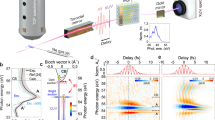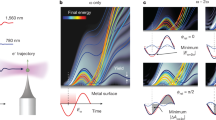Abstract
The possibility to excite and control charges in matter on ultrafast timescales is a key requisite to overcome the current limits of information transfer and data processing. The major route towards this milestone is based on the employment of short light pulses to manipulate the electro-optical properties of a solid. Nevertheless, the elusive physical mechanisms that unfold on extreme timescales are often complex and entangled, hindering their correct identification and possible exploitation. Here we investigate light-driven excitation in monocrystalline germanium by using attosecond transient reflection spectroscopy. We show that the complex regime established during light–matter interaction cannot be treated with simplified models but requires a detailed analysis in time and reciprocal space to address diverse phenomena such as tunnelling, band dressing, intra-band motion and multiphoton injection. Although single-photon absorption activates and develops earlier during excitation, two-photon processes, tunnelling and other field-driven phenomena reach their maximum effect soon after the peak of the pump pulse. Going against past observations, our results suggest that field-driven phenomena—namely intra-band transitions—can hinder charge injection, confirming that it is impossible to establish the next generation of petahertz information technology without a deep understanding of the diverse physical mechanism behind light–matter interaction.
This is a preview of subscription content, access via your institution
Access options
Access Nature and 54 other Nature Portfolio journals
Get Nature+, our best-value online-access subscription
$29.99 / 30 days
cancel any time
Subscribe to this journal
Receive 12 print issues and online access
$209.00 per year
only $17.42 per issue
Buy this article
- Purchase on Springer Link
- Instant access to full article PDF
Prices may be subject to local taxes which are calculated during checkout




Similar content being viewed by others
Data availability
The data generated and analysed in this study are provided in the Supplementary Information and/or Source Data. Extended data were available from the corresponding author on reasonable request. Source Data are provided with this paper.
Code availability
All the custom codes used in this study are available from the corresponding author on reasonable request.
References
Schoetz, J. et al. Perspective on petahertz electronics and attosecond nanoscopy. ACS Photon. 6, 3057–3069 (2019).
Borrego-Varillas, R., Lucchini, M. & Nisoli, M. Attosecond spectroscopy for the investigation of ultrafast dynamics in atomic, molecular and solid-state physics. Rep. Prog. Phys. 85, 066401 (2022).
Geneaux, R., Marroux, H. J. B., Guggenmos, A., Neumark, D. M. & Leone, S. R. Transient absorption spectroscopy using high harmonic generation: a review of ultrafast X-ray dynamics in molecules and solids. Philos. Trans. R. Soc. A 377, 20170463 (2019).
Schultze, M. et al. Attosecond band-gap dynamics in silicon. Science 346, 1348–1352 (2014).
Mashiko, H., Oguri, K., Yamaguchi, T., Suda, A. & Gotoh, H. Petahertz optical drive with wide-bandgap semiconductor. Nat. Phys. 12, 741–745 (2016).
Mashiko, H. et al. Multi-petahertz electron interference in Cr:Al2O3 solid-state material. Nat. Commun. 9, 1468 (2018).
Buades, B. et al. Attosecond state-resolved carrier motion in quantum materials probed by soft X-ray XANES. Appl. Phys. Rev. 8, 011408 (2021).
Sato, S. A. et al. Role of intraband transitions in photocarrier generation. Phys. Rev. B 98, 035202 (2018).
Lucchini, M. et al. Attosecond dynamical Franz-Keldysh effect in polycrystalline diamond. Science 353, 916–919 (2016).
Schlaepfer, F. et al. Attosecond optical-field-enhanced carrier injection into the GaAs conduction band. Nat. Phys. 14, 560–564 (2018).
Kruchinin, S. Y., Krausz, F. & Yakovlev, V. S. Colloquium: strong-field phenomena in periodic systems. Rev. Mod. Phys. 90, 21002 (2018).
Lucchini, M. et al. Unravelling the intertwined atomic and bulk nature of localised excitons by attosecond spectroscopy. Nat. Commun. 12, 1021 (2021).
Lucarelli, G. D. et al. Novel beamline for attosecond transient reflection spectroscopy in a sequential two-foci geometry. Rev. Sci. Instrum. 91, 053002 (2020).
Eskandari-asl, A. & Avella, A. Dynamical projective operatorial approach (DPOA) for out-of-equilibrium systems and its application to TR-ARPES. Preprint at https://arxiv.org/abs/2307.01244 (2023).
Heide, C., Boolakee, T., Higuchi, T. & Hommelhoff, P. Adiabaticity parameters for the categorization of light-matter interaction: from weak to strong driving. Phys. Rev. A 104, 023103 (2021).
Grinblat, G. et al. Ultrafast sub–30-fs all-optical switching based on gallium phosphide. Sci. Adv. 5, 1–6 (2019).
Chai, Z. et al. Ultrafast all-optical switching. Adv. Opt. Mater. 5, 1600665 (2017).
Goulielmakis, E. & Brabec, T. High harmonic generation in condensed matter. Nat. Photon. 16, 411–421 (2022).
Li, J. et al. Attosecond science based on high harmonic generation from gases and solids. Nat. Commun. 11, 2748 (2020).
Olofsson, A., Simpson, E. R., Ibrakovic, N., Bengtsson, S. & Mauritsson, J. Spatial control of extreme ultraviolet light with opto-optical phase modulation. Opt. Lett. 46, 2356 (2021).
Drescher, L. et al. Extreme-ultraviolet refractive optics. Nature 564, 91–94 (2018).
Kaplan, C. J. et al. Femtosecond tracking of carrier relaxation in germanium with extreme ultraviolet transient reflectivity. Phys. Rev. B 97, 205202 (2018).
Roessler, D. M. Kramers–Kronig analysis of non-normal incidence reflection. Br. J. Appl. Phys. 16, 1359–1366 (1965).
Kaplan, C. J. et al. Retrieval of the complex-valued refractive index of germanium near the M4,5 absorption edge. J. Optical Soc. Am. B 36, 1716 (2019).
Zürch, M. et al. Direct and simultaneous observation of ultrafast electron and hole dynamics in germanium. Nat. Commun. 8, 15734 (2017).
Higuchi, T., Heide, C., Ullmann, K., Weber, H. B. & Hommelhoff, P. Light-field-driven currents in graphene. Nature 550, 224–228 (2017).
Wu, M., Ghimire, S., Reis, D. A., Schafer, K. J. & Gaarde, M. B. High-harmonic generation from Bloch electrons in solids. Phys. Rev. A 91, 043839 (2015).
Yue, L. & Gaarde, M. B. Introduction to theory of high-harmonic generation in solids: tutorial. J. Opt. Soc. Am. B 39, 535 (2022).
Berggren, K.-F. & Sernelius, B. E. Band-gap narrowing in heavily doped many-valley semiconductors. Phys. Rev. B 24, 1971–1986 (1981).
Boolakee, T. et al. Light-field control of real and virtual charge carriers. Nature 605, 251–255 (2022).
Hui, D. et al. Attosecond electron motion control in dielectric. Nat. Photon. 16, 33–37 (2022).
Schultze, M. et al. Controlling dielectrics with the electric field of light. Nature 493, 75–78 (2013).
Ponath, P., Posadas, A. B. & Demkov, A. A. Ge(001) surface cleaning methods for device integration. Appl. Phys. Rev. 4, 021308 (2017).
Nisoli, M., de Silvestri, S. & Svelto, O. Generation of high energy 10 fs pulses by a new pulse compression technique. Appl. Phys. Lett. 68, 2793–2795 (1996).
Mashiko, H. et al. Double optical gating of high-order harmonic generation with carrier-envelope phase stabilized lasers. Phys. Rev. Lett. 100, 103906 (2008).
Itatani, J. et al. Attosecond Streak Camera. Phys. Rev. Lett. 88, 4 (2002).
Windt, D. L. et al. Optical constants for thin films of Ti, Zr, Nb, Mo, Ru, Rh, Pd, Ag, Hf, Ta, W, Re, Ir, Os, Pt, and Au from 24 Å to 1216 Å. Appl. Opt. 27, 246 (1988).
Géneaux, R., Chang, H.-T., Schwartzberg, A. M. & Marroux, H. J. B. Source noise suppression in attosecond transient absorption spectroscopy by edge-pixel referencing. Opt. Express 29, 951 (2021).
Bass, M. Handbook of Optics: Volume I—Geometrical and Physical Optics, Polarized Light, Components and Instruments (McGraw-Hill Education, 2010).
Nunley, T. N. et al. Optical constants of germanium and thermally grown germanium dioxide from 0.5 to 6.6 eV via a multisample ellipsometry investigation. J. Vacuum Sci.Technol. B 34, 061205 (2016).
Gerung, H. et al. Two-photon absorption of matrix-free Ge nanocrystals. Appl. Phys. Lett. 89, 111107 (2006).
Lehtola, S., Steigemann, C., Oliveira, M. J. T. & Marques, M. A. L. Recent developments in libxc—a comprehensive library of functionals for density functional theory. SoftwareX 7, 1–5 (2018).
The Elk Code (SourceForge, 2023); http://elk.sourceforge.net/
Tahini, H., Chroneos, A., Grimes, R. W., Schwingenschlögl, U. & Dimoulas, A. Strain-induced changes to the electronic structure of germanium. J. Phys. Condens. Matter 24, 195802 (2012).
Tahini, H., Chroneos, A., Grimes, R. W., Schwingenschlögl, U. & Bracht, H. Diffusion of E centers in germanium predicted using GGA + U approach. Appl. Phys. Lett. 99, 072112 (2011).
Di Ciolo, A. & Avella, A. The composite operator method route to the 2D Hubbard model and the cuprates. Condens. Matter Phys. 21, 33701 (2018).
Avella, A. Composite operator method analysis of the underdoped cuprates puzzle. Adv. Condens. Matter Phys. 2014, 1–29 (2014).
Avella, A. The Hubbard model beyond the two-pole approximation: a composite operator method study. Eur. Phys. J. B 87, 45 (2014).
Avella, A. & Mancini, F. Strongly Correlated Systems. Vol. 176 (Springer, 2013).
Mancini, F. & Avella, A. The Hubbard model within the equations of motion approach. Adv. Phys. 53, 537–768 (2004).
Schüler, M., Marks, J. A., Murakami, Y., Jia, C. & Devereaux, T. P. Gauge invariance of light–matter interactions in first-principle tight-binding models. Phys. Rev. B 103, 155409 (2021).
Acknowledgements
This project has received funding from the European Research Council (ERC) under the European Union’s Horizon 2020 research and innovation programme (grant agreement no. 848411 title AuDACE), from MIUR PRIN aSTAR (grant no. 2017RKWTMY) and Laserlab-Europe EU-H2020 GA no. 871124.
Author information
Authors and Affiliations
Contributions
G.I, L.A. and A.E. contributed equally to this work. M.L., M.N. and R.B.-V. conceived the experiment. G.I, N.D.P, G.L.D. and B.M. performed the measurements and contributed to the definition of the experimental procedures. G.I. evaluated and analysed the results, calculated the sample absorption and estimated the experimental excited electron density. A.L. and A.M. provided the samples. L.A., S.P. and C.A.R. designed, performed and analysed DFT and TDDFT simulations. L.J.D'O. and A.A. performed initial DFT calculations. A.E.-a. and A.A. developed DPOA, computed the dynamical bands and evaluated the inter/intra-band contributions. L.D. and A.E. computed electron populations in DPOA. All authors participated in the scientific discussion. G.I. and M.L. wrote the first version of the paper to which all authors contributed.
Corresponding authors
Ethics declarations
Competing interests
The authors declare no competing interests.
Peer review
Peer review information
Nature Photonics thanks Michael Zuerch, Vladislav Yakovlev and the other, anonymous, reviewer(s) for their contribution to the peer review of this work.
Additional information
Publisher’s note Springer Nature remains neutral with regard to jurisdictional claims in published maps and institutional affiliations.
Supplementary information
Supplementary Information
Supplementary Figs. 1–22, Discussion and Table 1.
Supplementary Video 1
Time-dependent 3D representation in the reciprocal space of the number of excited electrons.
Supplementary Video 2
Time-dependent evolution of the pumped band structure.
Source data
Source Data Fig. 1–4
Source data of Fig. 1–4
Rights and permissions
Springer Nature or its licensor (e.g. a society or other partner) holds exclusive rights to this article under a publishing agreement with the author(s) or other rightsholder(s); author self-archiving of the accepted manuscript version of this article is solely governed by the terms of such publishing agreement and applicable law.
About this article
Cite this article
Inzani, G., Adamska, L., Eskandari-asl, A. et al. Field-driven attosecond charge dynamics in germanium. Nat. Photon. 17, 1059–1065 (2023). https://doi.org/10.1038/s41566-023-01274-1
Received:
Accepted:
Published:
Issue Date:
DOI: https://doi.org/10.1038/s41566-023-01274-1



